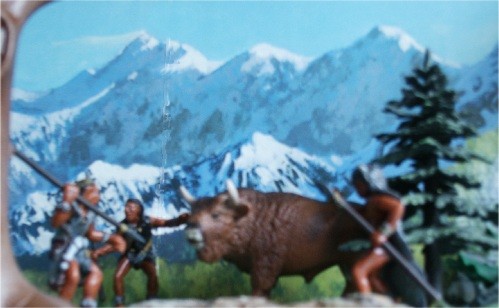 Click on the Site A icon to the right for Dioramas organized by
period or by manufacturer.
Click on the Site A icon to the right for Dioramas organized by
period or by manufacturer.  Click on the Site A icon to the right for Dioramas organized by
period or by manufacturer.
Click on the Site A icon to the right for Dioramas organized by
period or by manufacturer.
From the Dinosaur Collector
The Neanderthals update 9/15/09
lived from 100,000 to 28,000 years ago in Europe, Central Asia, Middle East and into Siberia. Neanderthals show the physical adaptations associated with living a cold climate. They appear to have been short and broadly built with males averaging about 5 1/2 feet tall. The jaw was strong with large teeth. The skull is characterized by strong brow ridges. The were stronger, had larger brains than modern humans and were physically adapted to the cold northern climate. They had survived several previous ice ages. A great deal of debate has been devoted to identifying the biological basis for the difference between Neanderthals and modern humans. There is a "Darwinist" bias toward explaining the disappearance of the Neanderthal as an evolutionary failure or biological inferiority. It has been suggested they lacked the physical ability to talk like modern humans, were without the mental abilities to create art or plan for the future. The lack of the hyoid bone (for the tongue) needed for speech has been disproved. The hyoid was located lower than modern humans, closer to the placement in modern females so neanderthal would have spoken with a higher pitch. In the last generations Neanderthals started using more modern tool sets, producing symbolic art objects even musical instruments. Burials and cave bear skulls suggestive of ritual have been found. Lumps of pigment have been found at sites so perhaps they were used for decorating the body. The material culture changes has been dismissed as the result of contact with moderns and imitation. Much like our alphabet is based on imitating the writing invented in the middle east. It seems to me their ability to appropriate the new technologies tells us they were more like than unlike us mentally. The Neanderthals appear to have had a very conservative culture specialized for living in a severe northern climate. When the climate changed and the forests were replaced by tundra Neanderthals could have been vulnerable but they had survived the past changes when the ice advanced and retreated. The simplest explanation might be that modern humans with a culture that allowed a higher population density displaced and out invented the Neanderthals because there were just more of them per acre. Just as Europeans replaced local peoples in the Americas and Australia because they had more effective tools and food production not from any biological difference.
The links will take you to diorama showing figures from this period. The site A and Site A icons will take you to the home pages for more selections.
The Neanderthal seem to have organized themselves differently from their modern human neighbors. One idea based on the placement of hearths or fire pits is that the females and males lived separately or at least organized their work independently. Tooth wear has suggested that extensive use was made of the jaw and teeth perhaps in preparing hides. Certainly Neanderthal culture must have been different from that of the incoming moderns. No needles have been found so hides must have been crudely worn. In the summers the short heat conserving would have needed to shed heat so clothing would have been less important. They seem to have preserved the same material culture for thousands of years. This cultural conservatism may be the sign of strong religious concepts and taboos. In modern human society's religion serves to enforce cultural traditions and resist change.
Bullyland Neanderthal women. Bullyland has produced the best and most accurate prehistoric human figures to date. With Marx and other caveman sets all you get are male cavemen. No wonder they died out.
The Neanderthals were meat eaters to the same degree as the Inuit in the Arctic and do not seem to have made use of fish or plants . They appear to have specialized in hunting large game animals. The primary hunting tool was the stabbing spear. The average Neanderthal was much stronger than a modern human. Great strength would have been needed to wield the spears at close quarters. This style of hunting would have been best suited to a forested environment. One study shows Neanderthals the arms that used the stabbing spears were hyper developed. They would have hunted the mega fauna Mammoths, Rhinos, the European Bison or Wisent, and Aurochs. Evidence also shows they hunted deer and boar where larger prey was rare. Shell fish, pine nuts and other non meat sources we consumed but the lack of specialized tools for processing non meat products seems to indicate they were minor components. Moderns are thought to have utilized a mixed diet, the classic hunter gather life style with plant food making up as much as 70% of their food. The result seems to be that Neanderthals were thinner on the ground with a lower population density than moderns. They may also have been more vulnerable to food shortages and slower to rebound after famines, although bone comparison studies of Inuit and Neanderthals seems to show that Neanderthals were at least and possibly better fed than their modern counter parts. They seem to have a less developed inner ear bones that would indicate a reduced agility. The spread of tundra would not have been favorable their weaponry. It would have favored hunters with an agile style of hunting and longer range weapons like spear throwers..

Neanderthal Hunters and shaman Schleich Wisent.
Neanderthals appear to have lived in smaller groups with fixed territories favoring hill top camps. Moderns favored river valleys and migrated over a larger area exploiting a wider range of food sources. Moderns also appear to have used symbolic objects and art to maintain wide ranging cultural networks. The lack of trade a networks and the exchange of goods may have slowed and limited the spread of ideas and technology. The Cave Bear seems to have been the special totem of the Neanderthals. Skulls were saved and a flute made from its bone has been found. The animal was large and formidable prey even if mainly a vegetarian. Killing it at close quarters with stabbing spears must have been dangerous. Neanderthal skeleton's typically exhibit broken bone and other injured consistent with this style of hunting.
Bullyland Neanderthal and Schleich Cave Bear.
Some controversial fossil evidence exists for interbreeding between modern humans and Neanderthals. If fertile offspring resulted they do not appear to have been numerous since no genetic makers have been identified. Neanderthal mitochondria DNA has been isolated and it shows distinct differences with that found in modern populations. This is not surprising but does not eliminate the possibility of interbreeding. Mitochondrial DNA is passed down only through the female line. In a small population the DNA would be lost in the same way that over time in small communities everyone will have the same last name. Some females will have no daughters and their mitochondrial DNA will be lost even though they still contribute to the general gene pool. One interesting idea is that about the same time that moderns encountered Neanderthals a gene that has been linked to larger brain size appears. Neanderthals did have a larger average brain size.
It was once thought that Neanderthals were strictly carnivores, but we now know that they ate a wide variety of plants. The majority of their diet was beans and nuts—they had a particular fondness for pistachios. But if I eat even one bean or nut I go into anaphylactic shock. True, wild barley was on the list of more than 50 plant species found at a Neanderthal site in Israel,
 Click on the Site A icon for Dioramas organized by
period or by manufacturer.
Click on the Site A icon for Dioramas organized by
period or by manufacturer.